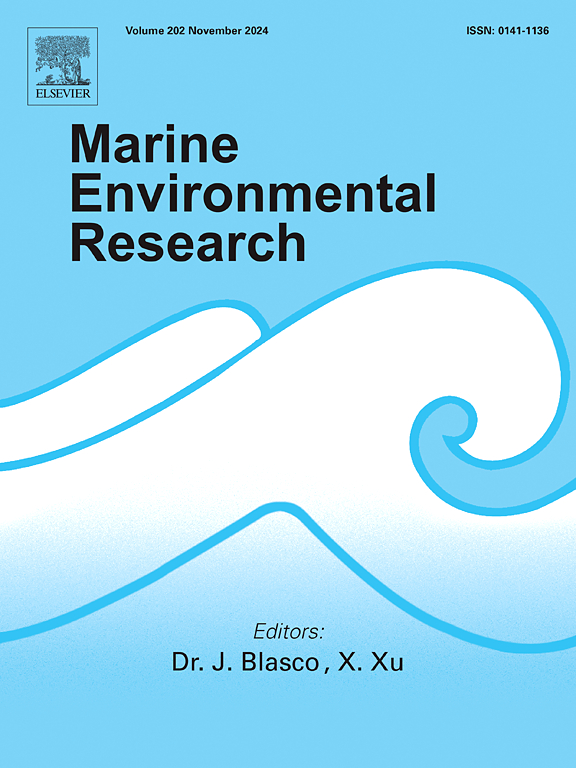香港尾海亚热带珊瑚礁两个海岸生境的珊瑚鱼和腹足类组合的空间变异及生境偏好
IF 3.2
3区 环境科学与生态学
Q2 ENVIRONMENTAL SCIENCES
引用次数: 0
摘要
由于食物供应和避难所保护的可变性,沿海栖息地的复杂性可能影响这些地区的生物多样性。珊瑚礁和大型藻床是维持海洋生态系统中鱼类和无脊椎动物更丰富的两个重要的沿海栖息地,因为它们具有高生产力和结构性庇护。香港有高度多样化的珊瑚群落和季节性马尾藻床。在二零二三年三月至二零二三年五月期间,我们在西贡五个珊瑚群落和五个马尾藻床进行了为期三天的珊瑚鱼和腹足类动物群落调查。马尾藻生境的平均珊瑚鱼丰度为278.58±40.39 (60 m−2),高于珊瑚生境的134.44±35.13 (60 m−2)(p < 0.01)。马尾藻生境腹足类平均丰度为207.56±25.58个(60 m−2),高于珊瑚生境的64.89±6.65个(60 m−2)(p < 0.001)。珊瑚鱼丰度与珊瑚覆盖呈显著正相关(rS = 0.464, p < 0.01)。此外,珊瑚鱼和腹足类的物种丰富度、丰度与马尾藻密度无关(物种丰富度:珊瑚鱼:rS = 0.013, p > 0.05;腹足类:rS = 0.100, p > 0.05;丰度:珊瑚鱼:rS = 0.231, p > 0.05;腹足类:rS = 0.217, p > 0.05)。此外,珊瑚鱼和腹足类的物种组成也与马尾藻生境有显著差异(珊瑚鱼:p <; 0.001;腹足类:p <; 0.001)。总体而言,一些鱼类表现出生境特异性,它们可能在马尾藻生长季节从珊瑚群落迁移到马尾藻床,或者在幼鱼时期栖息在马尾藻床上以获取食物资源和避免捕食。此外,大多数腹足类动物不具有生境特异性,但马尾藻床中可能存在有利的特征,导致腹足类动物的丰度较高。为了更好地了解珊瑚礁鱼类的关系,珊瑚鱼的丰度与珊瑚属多样性呈负相关(rs = - 0.413; p < 0.01)。不同地点的珊瑚鱼和珊瑚组成也存在显著差异(珊瑚鱼:p <; 0.001;珊瑚:p <; 0.001),珊瑚鱼组成可以通过珊瑚组成进行结构。Acropora、Platygyra和Pavona是影响珊瑚礁鱼类组成的重要变量,表明它们的存在和覆盖程度是构成栖息地珊瑚礁鱼类组合的重要因素。本文章由计算机程序翻译,如有差异,请以英文原文为准。
Spatial variation and habitat preference of reef fish and gastropod assemblages from two coastal habitats in subtropical reef, Port Shelter, Hong Kong
The complexity of coastal habitats could influence the biodiversity in such areas due to the variability of food availability and refuge protection. Coral reefs and macroalgal beds are two important coastal habitats for sustaining a greater abundance of fishes and invertebrates in marine ecosystems because of high productivity and structural refuge. In Hong Kong, there were highly diverse coral communities and seasonal Sargassum beds. A survey of reef fish and gastropod assemblages was conducted in five coral communities and five Sargassum beds in Sai Kung for three dates by SCUBA diving from March 2023 to May 2023. We found that the mean abundance of reef fish (278.58 ± 40.39 individuals 60 m−2) in Sargassum habitats was higher (p < 0.01) than that (134.44 ± 35.13 individuals 60 m−2) in coral habitats. The mean gastropod abundance (207.56 ± 25.58 individuals 60 m−2) in Sargassum habitats was higher (p < 0.001) than that (64.89 ± 6.65 individuals 60 m−2) in coral habitats. The abundance of reef fishes was found to be positively correlated to coral cover (rS = 0.464, p < 0.01). Moreover, species richness and abundance of reef fishes and gastropods showed no relationship with Sargassum density (Species richness: reef fishes: rS = 0.013, p > 0.05; gastropods: rS = 0.100, p > 0.05; Abundance: reef fishes: rS = 0.231, p > 0.05; gastropods: rS = 0.217, p > 0.05). Furthermore, the species composition of reef fishes and gastropods from coral habitats was also significantly different (reef fishes: p < 0.001; gastropods: p < 0.001) from Sargassum habitats. Overall, some fish species exhibited habitat specificity by possibly migrating from coral communities to Sargassum beds during the Sargassum growth season or as juveniles to inhabit Sargassum beds for food resources and to avoid predation. In addition, most gastropod species were not habitat-specific, but there might be favorable characteristics in Sargassum beds resulting in higher gastropod abundance. To better understand the coral-reef fish relationship, the abundance of reef fishes was found to be negatively correlated to coral genus diversity (rs = −0.413; p < 0.01). Reef fishes and coral composition also significantly differed (reef fishes: p < 0.001; corals: p < 0.001) among sites, and the reef fish composition can be structured by the coral composition. Acropora, Platygyra, and Pavona were significant variables shaping the reef fish composition, suggesting their presence and coverage as important factors in structuring the reef fish assemblage in a habitat.
求助全文
通过发布文献求助,成功后即可免费获取论文全文。
去求助
来源期刊

Marine environmental research
环境科学-毒理学
CiteScore
5.90
自引率
3.00%
发文量
217
审稿时长
46 days
期刊介绍:
Marine Environmental Research publishes original research papers on chemical, physical, and biological interactions in the oceans and coastal waters. The journal serves as a forum for new information on biology, chemistry, and toxicology and syntheses that advance understanding of marine environmental processes.
Submission of multidisciplinary studies is encouraged. Studies that utilize experimental approaches to clarify the roles of anthropogenic and natural causes of changes in marine ecosystems are especially welcome, as are those studies that represent new developments of a theoretical or conceptual aspect of marine science. All papers published in this journal are reviewed by qualified peers prior to acceptance and publication. Examples of topics considered to be appropriate for the journal include, but are not limited to, the following:
– The extent, persistence, and consequences of change and the recovery from such change in natural marine systems
– The biochemical, physiological, and ecological consequences of contaminants to marine organisms and ecosystems
– The biogeochemistry of naturally occurring and anthropogenic substances
– Models that describe and predict the above processes
– Monitoring studies, to the extent that their results provide new information on functional processes
– Methodological papers describing improved quantitative techniques for the marine sciences.
 求助内容:
求助内容: 应助结果提醒方式:
应助结果提醒方式:


